Hellscreen Interview: Jamie D Reflects on His Inspirations and Ideologies
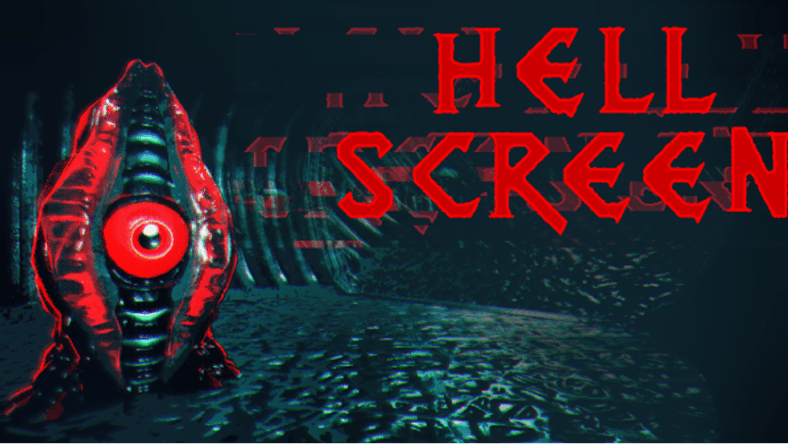
How many times have you been killed in the latest high-intensity action FPS game because once again, you got flanked, you got snuck up on, or one of the many airborne munitions collided with the soft back of your head? If only there was a solution to this problem! This is what was going through Jamie Degen’s head when he first conjured up the idea for his upcoming FPS shooter Hellscreen, a game where you fight like hell, thanks to the rear-view mirror you use to watch your six.
The insane concept initially drew me in, but the cool gunmetal grays and blues of the world kept me there. As I saw more of the crazy shooter and saw the public excitement for the project grow, I wanted to learn more about the title, the developer, and the care that had gone into making this, once again, completely bonkers concept work. Thankfully, Jamie has not been miscategorized due to a programming error in the afterlife’s processors, so he had no trouble finding time to pry himself away from his multiple screens to talk to me. After thanking him for making the time to speak with me, and exchanging our introductions, I dived into the questions I had regarding Hellscreen, how it came to be conceived, and how it has been received.
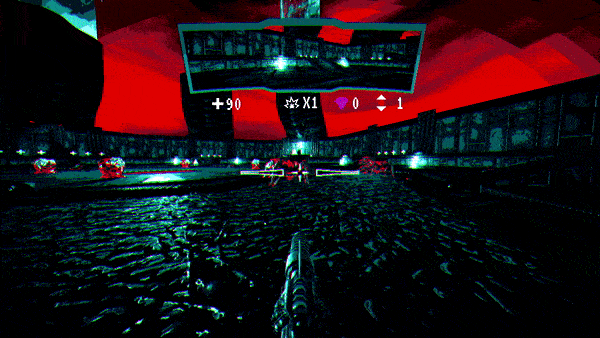
Starting the conversation, I took a moment to tell Jamie how cool his game and its unique mechanics looked, and how everyone has a unique idea for their game but it is not every day that someone’s unique idea elevates the gameplay in a way that grabbed my attention the way that Hellscreen did.
Jamie Degen: I would kind of agree with that. I mean, you know, obviously I look at a lot of games sort of just as part of my job, I mean, like, you know, working on Hellscreen. And I’m hard to impress, because when I see stuff, I kind of get a bit bored. So I did try and make a point of making the game standout with the mechanic and make it stand out visually, because I think that’s important, from a business point of view, you know, to even get noticed on Steam, because so many hundreds of games get released every week.
Moving on to the questions I had prepared for the interview, I wanted to get an idea about how long Jamie had been working, not only on Hellscreen, but in general as a game developer, so I asked if he could tell us about his career in game development, as well as what drew him to this line of work?
JD: : So, I wanted to be a game creator, I’m gonna use the word creator specifically until later on, but I wanted to be a game creator the first time I saw Sonic the Hedgehog at my cousin’s birthday party. And I had no idea what it was, like, I didn’t even know what a video game was. Which is bizarre to me now. So we’re talking like 1990, 91, maybe 1992, and from the first time I saw that, I wanted to know everything about video games. This probably would have been around 1992 actually, when my youngest sister was born, and my parents bought me and my brother, for being good whilst my parents were in hospital, they bought us a Master System. And from then on, I was hooked. And I knew that whatever this thing was, these things called video games, I wanted to do that for a living, I wanted to make those when I grew up. And it was only really when I was 18 I realized you could do it as a career. Everything I’d studied up to that point was actually trying to get into it, but that was the only point I realized you could do it as a career.
And from then it’s sort of just me trying to do it. So I’d say since I was about 7, and I’m 38 now. So it’s been a long time wanting to make games. And I think I’ve been in the games industry, I want to say 12, 13, possibly 14 years, something like that. I kind of entered into the non-indie games industry. So I worked with Travelers Tales, who made the LEGO games, that was my first long term job. And then I join a few startups after that, and was at Bossa Studios for a while. And then freelanced for about four or five years before stopping that to work on Hellscreen full time. I mean, cuz I’ve been working on Hellscreen for about 6 or 7 years, which is a long time.
As a follow-up, I asked if he was the solo developer during that time, or had he enlisted the help of others to finish the project?
JD: Yeah, pretty much. So aside from a music track, which I commissioned for a trailer, which is in the game now, all of it is done by me. But that, you know, the caveat is, there’s a couple of asset store things, not so much art assets, but things like Playmaker, which is like a node-based way of coding, so I use that to program. There’s Amplify shader editor, which is a shader editor, funnily enough. A couple of plugins and things but for the most part, it is pretty much me. because I actually joined the industry as an environment artist, and then ended up in things like VFX, lighting, and shaders, so it was quite a technical art background. And the only thing I was really missing was the programming thing. And once I discovered playmaker, which allowed me to make games, that’s kind of when it all kicked off really.
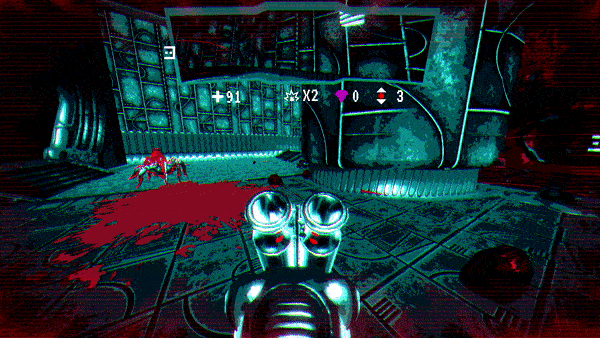
I commented that I would never fault anyone for using anything from the asset store. I think that’d be like faulting a painter for not making his own paint brushes.
JD: Definitely. I mean, I do lament when I see games on Steam which are just asset flips, or they take an art pack and haven’t really done much different with it. But at the same time, I’d rather that than no games use them at all. You know, because not everyone’s an artist, I mean, that’s what it comes down to. And not everyone has the money to hire, or all the time to train, so I totally get it. But I do sort of feel like if you’re putting out a game, you know, a visual medium, and you’re using graphics that you’ve not even attempted to change, I think it’s a missed opportunity.
I absolutely agreed, making games is hard, and asset stores help people flesh out ideas, but on the other hand, if the game offers nothing original, the player has no reason to stop and give their time to it.
JD: Yeah. I mean, the other part of that as well is that like, not every game that someone makes has to be a masterpiece, right? So it might be this game, they use asset store stuff, but the next one might be their, like, Citizen Kane, where they do everything.
On the topic of starting out in game development, I asked Jamie if he would tell us about how the idea for Hellscreen came about. Was it world first, then mechanics, or did he start with the concept of “FPS with rear-view mirror?”
JD: So, Hellscreen kind of came about because there were like, 3 or 4 ideas across my teenage years up until my adult years that sort of coalesced into Hellscreen organically, or by chance. So we’re talking about when I was 15 or 16 , I had Doom on the PlayStation One. And when I bought my PS1, it came with Alien trilogy, which I liked, but I didn’t love, especially after I played Doom. And what I really wanted was an action game that played like Doom but looked like Alien trilogy with all the aliens and the Giger stuff, and all that. And that was sort of one part in my mind. And then there was kind of a joke, a kind of thought experiment where I was talking to someone about how I’m terrible at online multiplayer first person shooters, and I always felt like, it seems the game is whoever sees someone first wins. It doesn’t ever seem to be an even firefight. Now, that’s because I’m terrible at these games.
But the idea that if someone sees you first your dead sort of made me think, “Well, how could you solve that?” And I jokingly thought, “Well, how about like a rearview mirror? You know, you can see behind you and all that.” And it was that, it was just that joke that kind of stuck with me. So when I decided that I wanted to learn more of Unity, to make my own game, I was like, “Well, the thing I’ll learn to make Unity with is a first person shooter.” I thought, “Oh, I’m gonna stick a rear view mirror in to see if I can.” And then I did. And it was kind of funny, and I thought “oh, wait, I could fly behind me, and that’d be cool. And then I could have enemies which are invisible to the main view, but not in the mirror.” And once I started thinking about all these ideas to build a game around, it kind of became obvious what the game should be, and I ran with it.
So taking this idea of like, well, I want to make an old school Doom game, which looks like Alien trilogy. And by that point, I discovered way more about H.R. Giger and got really into the Alien films, obviously, I was like, “Cool, I’m gonna do this kind of low-fi, low-res Giger-type thing… So it’s quick to make a cool art style. And then it just sort of grew into what it is now, really. The only reason why it ended up becoming a bigger game is because I had some publisher interest at the time. And I was like, “Oh, well, if they’re interested, maybe this could be a full game.” And so I kind of ran with it. And that was many, many years ago, but I just sort of stuck it out.
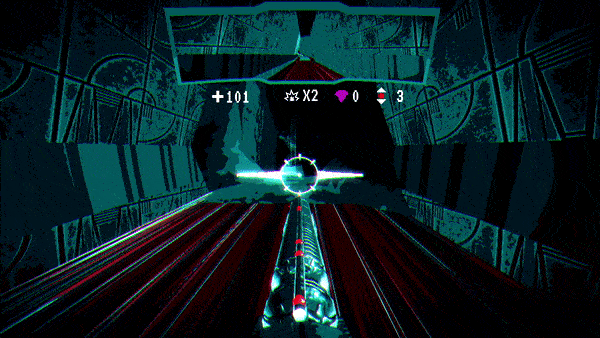
I told Jamie that it was great to hear how naturally the idea evolved, as I had said, making games is hard, so it was nice to hear that at the very least he had gotten a break creatively.
JD: Yeah, especially because when I was designing, it seemed interesting to design for. And sort of the more I thought about what the game was doing, the more that it kind of, ‘solve problems’ is maybe the wrong word, but certainly, I sort of realized that I have watched people play a lot of FPS games. And I realized that a lot of the things that people were doing was they would run backwards and shoot, and that’s kind of interesting to me. And the idea of having a rear view mirror. I was like, “Well, now you don’t even have to run backwards, you can run toward something, run past it and then shoot behind you.” And the idea of it just changing movement on the base level was interesting to me. And once I did all the things like, certain images you can see in the rearview mirror, there’s hidden doors. I was like, “all right, this seems interesting to design for and it doesn’t seem so complicated that it would put players off.” So I was like this must be hopefully a good thing to sort of pursue
Speaking about the visual inspiration for Hellscreen, Jamie had mentioned H.R. Giger a few times, but I was curious as to what else had inspired the cool gunmetal gray and blue world of Hellscreen, so I asked Jamie if he could shed some light on the other inspirations for his title?
JD: Well, just to give a quick background, the visuals start in the colors that you mentioned. I wanted to do a stylized game. And I was like, “Cool, I’m gonna keep the color count low,” because I had a really great plugin that lets you crunch colors and things. And I did some things that kind of made it a bit different. I didn’t want to make a game which was black, white, and red, because it felt like I’d seen that and I was like, “Well, if I make it blue and red, that kind of gives it a bit more flavor and stuff.” And that’s why I went with that. In terms of like, other sorts of arts and things, not so much artists, but certainly architecture. Like, brutalism was a big inspiration. Any kind of foreboding buildings that I saw, I’d take a picture of and put in a little folder somewhere.
I mean, the game Jedi Knight inspired me in terms of the scale of some of the levels, because I noticed that some of the levels, the actual gameplay area wasn’t huge, but the implied geometry around the level was, and I love that. There’s some of that in Hellscreen where we’ll have big monoliths or big archways and things. I can’t really think of any artists consciously that have inspired me. I mean, there’s always things which kind of sneak in there, but it was mostly like Giger and brutalism. You know, probably stuff I’ve seen on Twitter, but I can’t recall, it was generally like a mishmash of things.
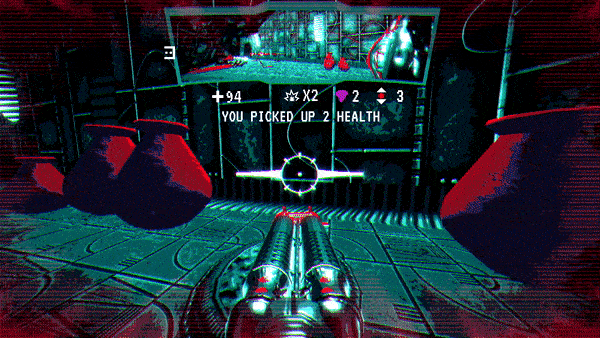
Staying on the topic of inspirations, I asked Jamie if he would tell us a bit about the world and conflicts of Hellscreen, and what he drew inspiration from when creating this world?
JD: So the general story is that the Hellscreen is a dimension-slash-planet which contains a supercomputer built by ancient gods to determine who goes to heaven and who goes to hell, because they themselves got tired of living and wanted to automate all their own tasks so they could die. So yeah, there’s this giant machine, the Hellscreen machine, which is almost like a living entity, it’s a hive, almost. But after millennia of working, it starts malfunctioning, and as a result of that, the player character rather than being sent to heaven, or the good afterlife, gets dragged to the Hellscreen machine. And so the player must go through the levels, getting access to various parts of the Hellscreen machine, and then eventually destroy it, to kind of reset the balance of souls in the world. I kind of wanted to do this thing where the Hellscreen machine, the way it looks, it wasn’t so much determined by how the gods lived. But because it inherently is somewhat of an evil place, even though it’s kind of like a limbo, a lot of its world design was based on human evil. So, you know, there’s guns, tech, and environments, which are inspired by different periods in human life. So that’s why there’s industrial levels, there will be an episode with more Gothic Castle levels, because the Hellscreen will just arbitrarily pick things from human history, and place them in its world as it grows out. So yeah, the player is trying to stop this sentient machine. I mean, I hesitate to call it sentient, it’s more like a weed or something, it’s more like the red weed from war of the worlds which is kind of growing and consuming everything…
I just liked the idea of something which was almost like a force of nature, you know, like locusts or something. And that the player was going against this massive, living building, almost. I mean, it’s not so much a building because it’s kind of scattered locations, but I just liked the idea of this breathing thing that had mechanisms. And, you know, it’s got like, there’s a level in episode one called the turbine. And I pictured that to be like a cooling system for this machine. You know, it just allowed me to be nonsensical in terms of the locations I put in there while still having an overall theme…
And one thing I really want to add in episode two, I don’t really hint towards in episode one, I love the idea of like, leaving giant sized things in the world to imply that maybe these Gods were humanoid. Like, I haven’t decided what. I really love the idea of having a giant Thor’s hammer. And I’m not even saying it’s Norse gods, I’m just saying, ancient beings. But like a giant hammer or a giant chair, or something, or some remains. It doesn’t have to make too much sense, just imply a scale, I think that can be interesting.
I compared that feeling to the point in the first Alien film when they find the Space Jockey pilot, but have no context or clues as to what it is or how it got there.
JD: That’s a great point. And again, that kind of speaks to that thing of, like, absorbing ideas and stuff. Because I think if you play a game, and there’s an implied history which happened before you got there, and things have sort of gone to chaos or whatever, that’s always interesting to me, you know… I don’t really put a lot of story at the forefront for the player. Like, it’s very much doing the old school classic Doom thing. You’re here in this situation, and it’s just kind of happening, so there’s not there’s not much in the way of cutscenes or anything like that. It’s just like, you’re in this world, and you’ve got to get to this place…
I’ll probably have a bit of text which explains why you’re there. But I think the appealing thing about the game is the look of the world you’re in and the mirror, and I don’t think the story will really add a massive amount. I mean, context is good, but it’s not gonna be cutscenes, it’s not gonna be constant dialogue. You don’t even really hear from anyone while you’re playing the game, there’s no radio chatter or anything like that. It just is you in this lonely world, this ecosystem really.
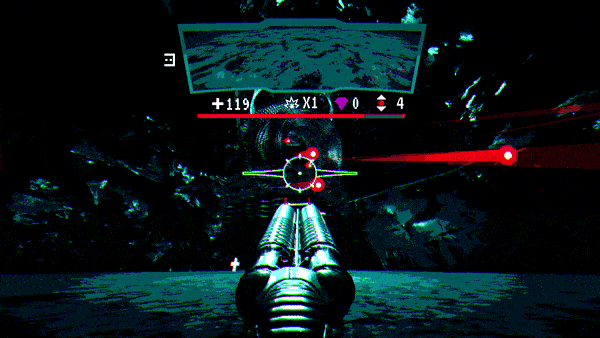
While we were talking about the story of the title, I asked James if the player should expect to see the world fleshed out in episode one, or will the first episode mostly be for learning the mechanics, leaving any lore for the second and third episode?
JD: I think the majority of the heavy hitting stuff will be in episodes two and three. I’m almost kind of treating episode one, like a giant tutorial. That was the wrong word, but like an easing in because the mirror and firing backwards, it can do a number on your brain, it can be a bit weird. So I want to give people enough time to kind of get adjusted to it. That’s not to say that episode one isn’t a full experience, because I think it is. But I think I think more of the story, the deepest stuffs gonna be in episode two and three.
I totally got where he was coming from, and I commented that I wasn’t sure I’d be able to really absorb any lore while trying to wrap my head around the mechanics of his title.
JD: Right, right. And the thing is, I do introduce the player to quite a few enemies in episode one. And I want to introduce more in episode two. But by the time episode two starts, I’m expecting the player to be pretty good at what they do. So to me, episode two is almost like, the game. I mean, episode one is as well, but episode two is like, now you’re equipped, you know how to play, let’s go…
best way to put it, like I said, in episode two I expect the player to be jumping around way more and use the weapons in conjunction and they’re like, quick switching and all that kind of stuff. I mean, you probably were in episode one as well. But like, I think episode two will be like, you know the game, you know what you’ve got to do to deal with these enemies, but there’s some more like it should be, episode two will be the ultimate Hellscreen experience.
As he had said before, it sounded like Jamie had three episodes planned, but out of curiosity I asked if the game sold gang busters, or he is hit with inspiration, would he make additional content, or is the three chapters all he was willing to complete for a single title?
JD: It’s a good question. I don’t know, I mean, three chapters, definitely. I’ve got a feeling that I will want to revisit Hellscreen after it’s done, and maybe do some standalone maps. I’ve toyed with the idea of maybe hiring a few folks to do a community pack almost like a map pack or something. But I haven’t I haven’t made any concrete plans yet. I was assuming that once episode three was done, or will be done rather, that I would not want to look at Hellscreen again for a long time. But even as I am bug fixing on Hellscreen episode one, I cannot wait to get stuck into episode two. And I’m still excited to work on it. Usually when I work on a project, even after six months I’m kind of ready to be done with this. But Hellscreen is something which keeps bringing me back, which is why I enjoyed making it because of the problems that it gives me to solve and the things I can try and you know, I find it very expressive for me.
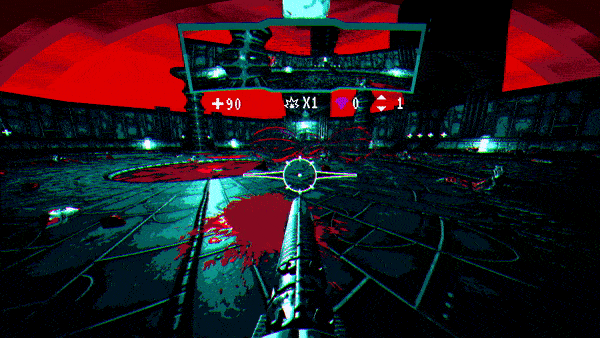
I was happy to hear that working on Hellscreen was so rewarding, making games is hard, as I often say, so it is nice to hear that a dev hasn’t had to sacrifice their vision or what works for them in order to appeal to a wider audience.
JD: I mean, it’s interesting because I didn’t think that anyone would give a shit about Hellscreen. I felt like, because when I started working, I think this was probably before Dusk, at least before I knew of Dusk, I remember I had this game idea when I was 16. I’ll make that and I’ll get it out and it will probably go on itch. So I wasn’t even thinking Steam back then. And then just see what happens next, you know, to prove to myself whether I could make a game or not, because I’ve never really done that. Well, I mean, I’ve done Game Jam stuff, but actually put out a game on a website. So when people are interested, I think maybe this is cool, and I stick with it. And the community support has been really, really good and helped sort of motivate me, and I just want to finish it because I realized that I like working on it. And it’s interesting to me, I mean, if the game comes out and it bombs, I can still say I made a game which I find interesting. And hopefully I’ll like to play once it’s done. Because again, I don’t often like playing stuff that I’ve worked on. But this seems to be the exception. So hopefully I’m on to a good thing.
Now that we had spoken about the world and mechanics of Hellscreen, I wanted to get some behind the scenes info on the development. Curious as to how the rear-view mirror affected development, I asked Jamie if there were any fun tricks or interesting ideas he was able to implement with the Hellscreen beyond giving players more awareness of their surroundings?
JD: I can tell you my favorite thing, two things that I’d quite like actually. So I wanted to do the Half Life thing, never taking control away from the player. So you’re always in that first person view. But because I treat the mirror almost like a screen, a literal screen, I can have little micro cutscenes in the mirror. So I’ve got a thing where if you pick up a certain key, which unlocks a certain door, when you pick up the key, the mirror will cut to almost like a CCTV camera of the door changing color to show that you’ve unlocked it. And it’s great because it means I can show these things and not take away control from the player, you know, and I really, really enjoyed doing that. Because it just means I can play with cameras and things. And, you know, maybe there will be more elaborate cutscenes that just are played in the mirror.
And the other thing I like doing is I’m doing that classic environmental storytelling thing of graffiti on the wall. But I’m having it when you look at it in the main view, it’s mirrored, it’s flipped. And then when you look at it in your actual rearview mirror, it looks the right way. It reads the right way. And that’s just kind of fun. I just thought that was kind of funny. But yeah, the, you know, part of what I tried to do, to varying degrees of success, is have as much UI on the mirror as possible, rather than having status bars at the bottom. Like older screenshots of Hellscreen have this kind of Geiger bar at the bottom kind of like you get in Doom classic. And I removed that and tried to put as much of it on the mirror as possible, so I was like “if i’m gonna have a mirror there I may as well use as much of that as possible.” So that’s been something else. It’s more just that it lets me do things a bit differently, which is kind of nice. It lets me sort of say, do I need to do this in a particular way? Or can I think of something which is more bespoke to my game? You know, which is great.
One question I had about the Hellscreen was how it functioned when the rear-view mirror became the main display. So I asked Jamie if the player’s controls will be inverted when looking at the world through the Hellscreen?
JD: It plays like normal. But what’s interesting about the mirror is if you imagine a mirror literally floating in front of your face, if you were to look up or down, if you were looking up it would show you the floor if you’re looking down at show you the sky, but the mirror in Hellscreen, if you look up, it shows you up behind you. So it kind of follows your angle. So it is a bit weird when I explain it, but in practice, it feels way more intuitive. So it’s almost like there’s a camera at the back of your head, which mimics the angle of your head, and then projecting that onto a screen in front of you. I know that sounds really confusing, but when you play it, it feels quite a bit more intuitive… It was weird because it was one of those things that I got used to. But then when I put the demo on Steam next people were really struggling. And so, you shouldn’t really change the demo when it’s out. But I ended up basically inverting the way the camera or the mirror works on the vertical axis and people got on with it a lot better. So I expect it’s kind of going to be a bit of the left handed right handed thing where some people like it one way, and some people like it another, but I’ll eventually add controls to change that anyway, so people can kind of make it work for them. But yeah, that was a lot of tweaking because it doesn’t feel intuitive as a game designer to make it work that way. But it just sort of felt better, you know?
Moving past the meat and bones of the title and onto the quickly approaching release date of March ninth, I asked Jamie if he had a rough idea how much gameplay the typical gamer may get out of the first chapter?
JD: Oh, you know what, I don’t know, I really don’t know, because I think it’s gonna be close to two and a half hours, I’m hoping it’s close to two and a half hours, but I haven’t tested it yet. And it’s hard, because when we put out the demo, I would play through the demo pretty quickly, in about 20 minutes. But other people spend about an hour on the demo. So it’s really hard to kind of gauge but, you know, part of the progression in the game is that you’ve got to collect, you don’t just play through a level and then move on to the next, you actually fast travel between different levels to collect these cores and you need a certain amount of cores to open certain doors, or rather, certain maps. So there’s going to be a lot of back and forth, there’s going to be quite a lot of rummaging around the levels trying to find all these cores, there’s 4 per level, for the most part. So game time is gonna vary, and I’ve got some sort of plans to add a bit of content to episode one after release. There’s at least one level that I want to add in, there’s another weapon on add in, just kind of like bonus secret stuff. So I think it’s gonna be, you know, let’s say, two to four hours, depending on skill level, speed running, and all that kind of thing, somewhere between there I’m hoping.

That was very cool to hear, for clarification I asked Jamie if he felt like that was two hours to just blow through it, maybe four hours to find all the secrets and easter eggs?
JD: I think so. I think we’re still gonna be balancing difficulty. You know, and at the moment, I’m just kind of releasing a general normal difficulty, but I do want to add a much harder difficulty for players that want to go back and be really challenged, kind of like a new game plus, actually, I’m kind of envisioning it.
I commented that I would most certainly be sticking to the standard difficulty, as I do not have that devil blood that makes the youth so good at FPS games, whenever I play a hard mode and get stomped, I have to remind myself that there is a teenager out there somewhere who can beat this without taking damage.
JD: Right. And it’s kind of hard to design for because I’m not someone who likes playing hard games, right? Like, I’m, like, I usually play on easy or normal just because I’m not there. I’m not often there for the challenge. I mean, sometimes I’ll put, like, old school Doom on something really hard, you know, for shits and giggles. But, you know, I want the game to be playable by as many people as possible. I mean, whether it appeals to them or not, I’m not sure, but I certainly don’t want it to be so annoyingly frustrating that it puts people off, I will put that mode in eventually, where it’s so annoyingly frustrating that it puts people off, but I want that initial experience to be easier the first time you play it rather than too hard. But you know, as I get feedback from players and things, I’m absolutely more than happy to tweak difficulty and stuff like that. I mean, you know, the games go into early access, but I’m still going to be addressing a lot of people’s feedback and stuff. And, you know, I do want to spend some time on it. So I’m really getting it where I want it before I move on to the sort of deeper parts of episode two. So it will improve well beyond release, you know.
Once the game releases on the 9th, I asked Jamie if he was going to continue working at the same pace, no stop, nose to the grindstone, or did he plan on taking a little break to recuperate before diving back into development?
JD: I’m gonna have a nice old break, I’m going to spend a week or two doing hot fixes, and like, really essential bug fixes, if any arise. I’m going to take some time out, me and my partner are gonna go on holiday because it’s well deserved. But I want a certain amount of distance from the game before I really get into the deeper parts of episode two, and even episode one in some cases, because I want to have a fresh set of eyes. And that’s not always possible when you’ve been, you know, crunching on a game for quite a while. So I definitely want to sort of come back to it with a new perspective and kind of look at where I can make things better. See what players think about certain things and then just make a really good decision about what to do about those things.
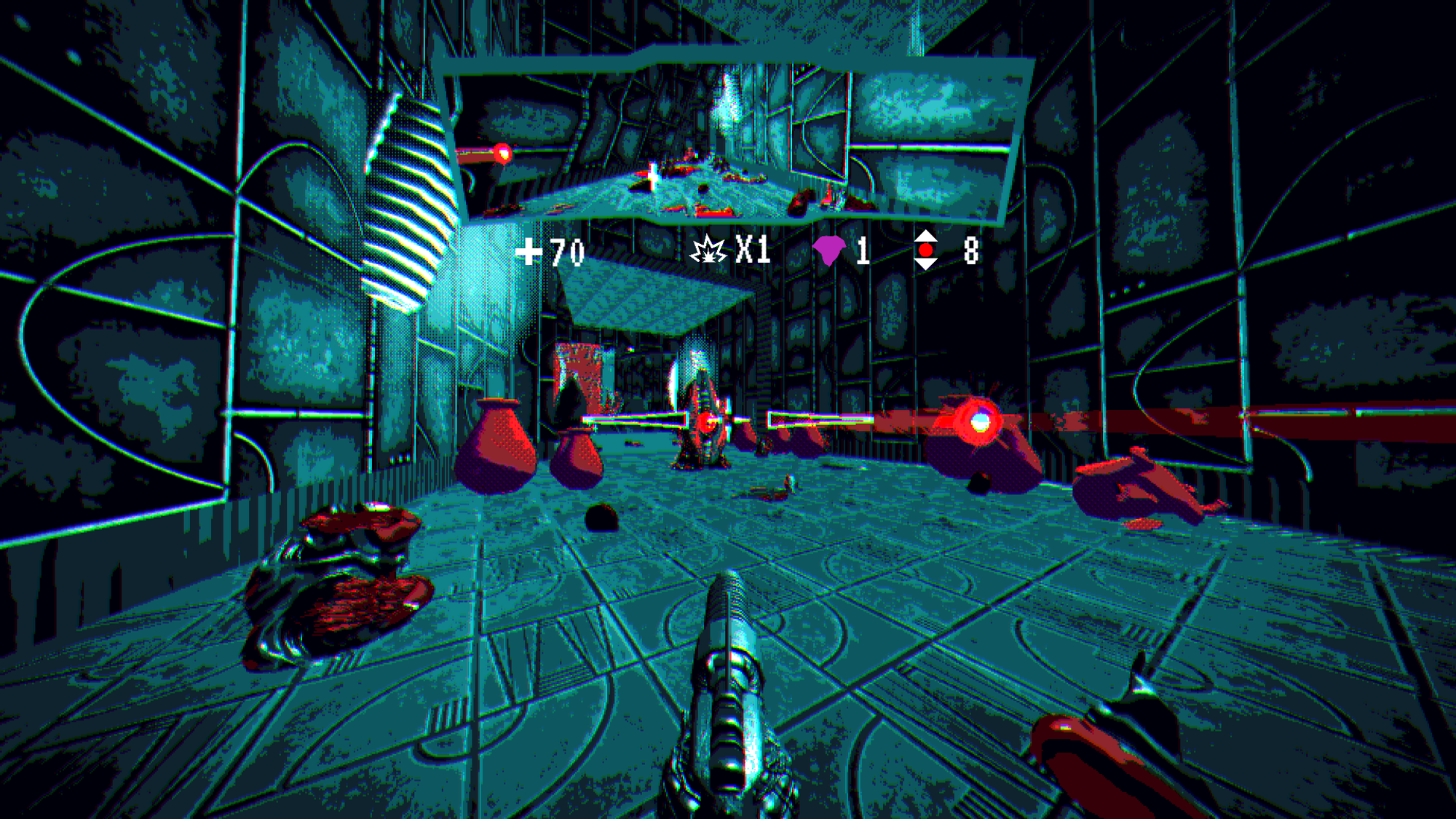
As a follow up I asked if he was more nervous or excited to see how the game would be received by the masses?
JD: That’s a good question, I am nervous to see what people think. I’m excited for them to play it. I’m expecting a lot of feedback. Because, you know, I am passionate, I think people will like it. I mean, the demo went down pretty well. I think people will generally like it. And I am looking forward to it, it’s a big personal milestone for me to get episode one out. It’s been a long time coming, and I’m really excited to see what people think about the game, you know, and to see what thoughts they have. Because I love talking about it. I love having conversations with people and other developers and things to see. What they might do differently or what they liked and what they didn’t like. So as long as people are nice, I’m always happy to talk about it.
On the topic of people talking about his game, on Twitter I had seen that there were some rather popular internet personalities getting hyped for the upcoming shooter. Some of the people have thousands upon thousands of followers, and regularly turn people on to indie shooters that most would never know about. So I asked Jamie how this attention from notable FPS fans made him feel?
JD: The funny thing is, GMan was following Hellscreen really early on, I didn’t actually know who he was at the time. He was super friendly, and we’d had a couple of chats and things and I had no idea about his work or anything. And then I started watching a bunch of videos but FPS and he popped up… I’m not gonna lie, if he makes a video about Hellscreen I’m probably not gonna watch it for a few weeks because I don’t think I’ll be brave enough, you know? Because he’s brutally honest. But, you know, it’d be cool, and certainly, like, it’s not just him, there have definitely been other people that have picked up on it. Like Dave Oshry, he’s tweeted about it a few times, which is cool. I think Icaruslives has been following it as well, which is great. It’s nice to be seen by anyone, it’s nice to be noticed by anyone. But like, certainly people that are, I don’t wanna use the word experts, but knowledgeable in those genres, that is pretty cool as well…
The truth is, like, I see the development of the game as an ongoing thing. So, I think I’ll come back to episode two, I’m going to tweak some things, and add the new content with episode two, and episode three as well. So it’s sort of like, to me, it’s always moving. So, you know, they might, Gman comes and says, “actually, this is a bit shit.” Like, great, you know, I’ll take that feedback, and I’ll work it into the next version of episode one or episode two, and then hopefully, he’ll review it again, and maybe he’ll like it this time. So you know, to me, it’s not a definitive kind of thing. It’s always in progress. It’s always moving… And the truth is that no one’s game is ever finished, it’s just released, right? And, you know, there’s certainly a few things in episode one where I was like, “oh, man, I don’t know about this, maybe I need more time.” But, you know, money and time isn’t an endless luxury. So you kind of got to sort of roll with it. But hopefully, there’ll be time and money to go back and fix whatever I want to fix in the future… But the other thing is, like, you know, I’ve worked in games a long time now. And I’ve never been in a situation where everyone was 100% happy with what went out. And that’s not to say it wasn’t good. It’s just to say people want to make things perfect. And actually, no one’s ever satisfied in that regard, you know.
I told Jamie I had been watching The Handmaid’s Tale, and they frequently say that “perfect is the enemy of good.”
JD: It really is, in fact my mom, she’s always saying,”you’re a bit of a perfectionist, Jamie.” And with Hellscreen I’ve deliberately tried to not be perfect, because I actually like the idea that maybe it’s a bit rough around the edges. I don’t want it to be, too polished is the wrong word, but, you know, I think it gives it character and you know, I’m a solo developer, so there’s only so much I can do, but I think maybe its quirks and its flaws are what makes it interesting. Rather than being like the latest AAA live-service game, which has just got no personality, you know.

That was absolute understandable, as I told Jamie, as a fan of like hardcore punk music and metal, there’s definitely something alluring about the gritty roughness over the clean, produced tones of a classic pop album.
JD: Yeah, that’s it, I was gonna say overproduced, like Hellscreen is not overproduced, it’s built to be quick and dirty. A bit rough, you know, but it’s it’s least memorable. I mean, I will say, when I go to a game developer meetups or sort of general gaming events, people will introduce me to other people, they’ll be like “oh, Jamie’s working on this game called Hellscreen.” And then they look at me blankly. And then the person introducing me will be like, “Oh, it’s like, it’s got this kind of blue and red kind of vibes got a mirror” and they go, “Oh, yeah, I know that game. I’ve been following the game on Twitter for ages!” So I know that it’s in people’s brains. And that’s kind of what I want, you know, it’s in people’s brains.
While that had wrapped up the questions I had prepared for Jamie regarding Hellscreen, I wanted to make sure that nothing was left out of the conversation that he would want to talk about, so before we ended our conversation, I asked Jamie if there was anything else he would like to share with our dear readers, whether it pertained to Hellscreen, or was just an anecdote or something for the readers to check out?
JD: I can’t really think of anything too much. I mean, like, Yeah, I can’t really think of anything. I don’t know if it’s an anecdote, but I would like John Romero to see this. Because I saw him at two different events, and I was too afraid to say hello. And it was annoying, because I was with a friend, and we both went up to him. And my friend was talking to John Romero like they’d known each other for 20 years. And I just stood there silent. And I was like, “I should show him my game,” but I never got around to it. So really, I would like Romero to see my game. That’d be a nice bonus accomplishment from getting this game out. But now, I can’t really think of anything. I think we covered a lot of good stuff. You know, I’m sure I’ll figure something out tomorrow. I always do. But I think this was a great conversation. I’m glad we had it.
Thankfully, if you are eagerly awaiting Hellscreen, you do not have much longer to wait, as the game will enter early access on Steam on March 9th, 2023. Be sure to wishlist the title ahead of time so you are notified when it goes live! To keep up to date on future developments for the title, be sure to visit the official page for Hellscreen, and to see what Jamie himself is up to, be sure to follow his personal Twitter page. And as always, if you are absolutely fiending for more information about the latest and greatest and ghastly, ghoulish gaming, then head back to DreadXP and read more of our frightful features!
Categorized:Interviews

